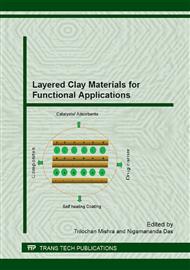[1]
S. Vial, C. Forano, D. Shan, C. Mousty, H. Barhoumi, C. Martelet and N. Jaffrezic, Nanohybrid-layered double hydroxides/urease materials: Synthesis and application to urea biosensors, Mater. Sci. Eng. C 26 (2006) 387-393.
DOI: 10.1016/j.msec.2005.10.069
Google Scholar
[2]
K.H. Goh, T.T. Lim and Z. Dong, Application of layered double hydroxides for removal of oxyanions: a review, Water Res. 42 (2008) 1343–1368.
DOI: 10.1016/j.watres.2007.10.043
Google Scholar
[3]
S. Mandal and S. Mayadevi, Adsorption of fluoride ions by Zn–Al layered double hydroxides, Appl. Clay Sci. 40 (2008) 54-62.
DOI: 10.1016/j.clay.2007.07.004
Google Scholar
[4]
S. Mandal and S. Mayadevi, Defluoridation of water using as-synthesized Zn/Al/Cl anionic clay adsorbent: Equilibrium and regeneration studies, J. Haz. Mater. 167 (2009) 873–878.
DOI: 10.1016/j.jhazmat.2009.01.069
Google Scholar
[5]
S. Mandal, S. Mayadevi and B.D. Kulkarni, Adsorption of Aqueous Selenite [Se(IV)] Species on Synthetic Layered Double Hydroxide Materials, Ind. Eng. Chem. Res. 48 (2009) 7893–7898.
DOI: 10.1021/ie900136s
Google Scholar
[6]
S. Mandal, D. Tichit, D.A. Lerner and N. Marcotte, Azoic Dye Hosted in Layered Double Hydroxide: Physicochemical Characterization of the Intercalated Materials, Langmuir 25 (2009) 10980–10986.
DOI: 10.1021/la901201s
Google Scholar
[7]
F.P. de Sa, B.N. Cunha and L.M. Nunes, Effect of pH on the adsorption of Sunset Yellow FCF food dye into a layered double hydroxide (CaAl-LDH-NO3), Chem. Eng. J. 215–216 (2013) 122-127.
DOI: 10.1016/j.cej.2012.11.024
Google Scholar
[8]
M. Ogawa, K. Kuroda, Photo-functions of intercalation compounds, Chem. Rev. 95 (1995) 399.
Google Scholar
[9]
Q.Z. Yang, J. Yang and C.K. Zhang, Synthesis and properties of cordycepin intercalates of Mg-Al-nitrate layered double hydroxides, International J. Pharmaceutics 326 (2006) 148.
DOI: 10.1016/j.ijpharm.2006.06.037
Google Scholar
[10]
H.C. Greenwell, W. Jones, D.N. Stamires, P. O'Connor and M.F. Brady, A one-pot synthesis of hybrid organo-layered double hydroxide catalyst precursors, Green Chem. 8 (2006), 1067.
DOI: 10.1039/b605851e
Google Scholar
[11]
S.P. Li, The dynamic process in the formation of Tyr/LDH nanohybrids, Coll. Surface. A, 290 (2006) 56.
Google Scholar
[12]
J. Plank, Z. Dai and P.R. Andres, Preparation and characterization of new Ca-Al-polycarboxylated layered double hydroxides, Mater. Lett. 60 (2006) 3614.
DOI: 10.1016/j.matlet.2006.03.070
Google Scholar
[13]
F. Malherbe and J.P. Besse, Investigating the effects of guest-host interactions on the properties of anion-exchanged Mg-Al hydrotalcites, J. Solid State Chem. 155 (2000) 332.
DOI: 10.1006/jssc.2000.8922
Google Scholar
[14]
S.P. Newman and W. Jones, Synthesis, characterization and applications of layered double hydroxides containing organic guests, New J. Chem. 2 (1998) 105.
DOI: 10.1039/a708319j
Google Scholar
[15]
M.X. Zhu, Y.P. Li, M. Xie and H.Z. Xin, Sorption of an anionic dye by uncalcined and calcined layered double hydroxides: a case study, J. Hazard. Mater. B120 (2005) 163.
DOI: 10.1016/j.jhazmat.2004.12.029
Google Scholar
[16]
G. Bascialla and A.E. Regazzoni, Immobilization of anionic dyes by intercalation into hydrotalcite, Colloid. Surfac. A: Physicochem. Eng. Aspect. 328 (2008) 34–39.
DOI: 10.1016/j.colsurfa.2008.06.028
Google Scholar
[17]
M.M. Bouhent, Z. Derriche, R. Denoyel, V. Prevot and C. Forano, Thermodynamical and structural insights of orange II adsorption by MgAlNO3 layered double hydroxides, J. Solid State Chem. 184 (2011) 1016–1024.
DOI: 10.1016/j.jssc.2011.03.018
Google Scholar
[18]
G. Crini, Non-conventional low-cost adsorbents for dye removal: a review, Bioresour. Technol. 97 (2006) 1061–1085.
DOI: 10.1016/j.biortech.2005.05.001
Google Scholar
[19]
V.K. Gupta and Suhas, Application of low-cost adsorbents for dye removal- a review , J. Environ. Manage. 90 (2009) 2313–2342.
DOI: 10.1016/j.jenvman.2008.11.017
Google Scholar
[20]
S. Sekar, M. Surianarayanan, V. Ranganathan, D.R. MacFarlane and A.B. Mandal, Choline-Based Ionic Liquids-Enhanced Biodegradation of Azo Dyes, Environ. Sci. Technol. 46 (2012) 4902-4908.
DOI: 10.1021/es204489h
Google Scholar
[21]
T. Tanaka, S. Nishimoto, Y. Kameshima, J. Matsukawa, Y. Fujita, Y. Takaguchi, M. Matsuda and M. Miyake, A novel nanocomposite material prepared by intercalating photoresponsive dendrimers into a layered double hydroxide, J. Solid State Chem. 183 (2010) 479-484.
DOI: 10.1016/j.jssc.2009.12.016
Google Scholar
[22]
L. Li, P. Liu, L. Zhang, D. Chen, Photophysical properties of donor - P- acceptor azoic chromophores adsorbed and intercalated into Mg–Al–LDH, J. Solid State Chem. 198 (2013) 218–223.
DOI: 10.1016/j.jssc.2012.09.018
Google Scholar
[23]
Y. Guo, Z. Zhu, Y. Qiu and J. Zhao, Enhanced adsorption of acid brown 14 dye on calcined Mg/Fe layered double hydroxide with memory effect, Chem. Eng. J. 219 ( 2013) 69-7.
DOI: 10.1016/j.cej.2012.12.084
Google Scholar
[24]
Y.P. Wei, D.Q. Wei and H.W. Gao, Treatment of dye wastewater by in situ hybridization with Mg–Al layered double hydroxides and reuse of dye sludge, Chem. Eng. J. 172 (2011) 872-878.
DOI: 10.1016/j.cej.2011.06.076
Google Scholar
[25]
L.E. Gaini, M. Lakraimi, E. Sebbar, A. Meghea and M. Bakasse, Removal of indigo carmine dye from water to Mg–Al–CO3-calcined layered double hydroxides J.Hazar.Mater. 161 (2009) 627-632.
DOI: 10.1016/j.jhazmat.2008.04.089
Google Scholar
[26]
M. Bouraada, F. Belhalfaoui, M.S. Ouali and L.C. de Ménorval, Sorption study of an acid dye from an aqueous solution on modified Mg–Al layered double hydroxides, J.Hazar.Mater. 163 (2009) 463-467.
DOI: 10.1016/j.jhazmat.2008.06.108
Google Scholar
[27]
E. Suzuki, S. Idemura and Y. Ono, Properties of hexacyanocobaltate(III)-exchanged hydrotalcite-like minerals, Clays Clay Miner. 37 (1989) 173-178.
DOI: 10.1346/ccmn.1989.0370209
Google Scholar
[28]
H.M.F. Freundlich, Over the adsorption in solution, J.Phys.Chem. 57 (1906) 385.
Google Scholar
[29]
I. Langmuir, The adsorption of gases in plane surface of glass, mica, and platinum, J. Am. Chem. Soc. 40 (1916), 1361.
Google Scholar
[30]
R.E. Treybal, Mass Transfer Operations, 3rd edition, McGraw-Hill Book Company, Singapore, 1981, p.590.
Google Scholar
[31]
S. Lagergren, About the theory of so-called adsorption of soluble substances, K. Sven. Vetenskapsakad. Handl. Band 24 (1898) 1–39.
Google Scholar
[32]
Y.S. Ho and G. McKay, The kinetics of sorption of divalent metal ions onto sphagnum moss peat, Water Res. 34 (2000) 735.
DOI: 10.1016/s0043-1354(99)00232-8
Google Scholar


